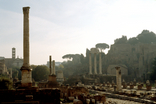Multimedia

(Photograph: Andrew Stephenson)
Byzantium 1200 Project and Museum
There is a new museum in Istanbul based on the Byzantium 1200 project, which aims to recreate the city of Constantinople as it was in the year 1204. Many buildings and monuments are shown in reconstruction on the web site.
The associated new museum in Istanbul, which opened in November of last year, is located at the Philoxenos (Binbirdirek) Cistern. There are many models and pictures of what Constantinople would have looked like in 1204.
Chartres: Cathedral of Notre-Dame
The Cathedral of Chartres, located some fifty miles outside Paris, is considered one of the most important cultural landmarks in France - and even Europe. In 2004, Professor Alison Stones of the University of Pittsburgh began to create an online collection of visual materials documenting this imposing structure. Working with some of her students and colleagues, this project was supported by the University's Digital Research Library and is now available to the web-browsing public. The breadth and depth of the collection's 3100 items is impressive, as it includes everything from seventeenth-century vistas of the city of Chartres to architectural drawings of interior features of the cathedral, such as the nave. A search engine provided on the site allows visitors to search for items by name, description, type of material or photographer.
DigiPal
DigiPal is a resource for the study of medieval handwriting, particularly that produced in England during the years 1000-1100, the time of Æthelred, Cnut and William the Conqueror. It currently has:
- 1675 records of manuscripts and charters
- 986 manuscript images
- 63880 images of letters (graphs)
- 1477 records of scribal hands
Funded by the EU FP7, it is based at the Department of Digital Humanities at King's College London.
Digital Scriptorium
The Digital Scriptorium is an image database of medieval and renaissance manuscripts that unites scattered resources from many institutions into an international tool for teaching and scholarly research. It bridges the gap between a diverse user community and the limited resources of libraries by means of sample imaging and extensive rather than intensive cataloguing.
Evellum
Evellum is an established leading producer of digital facsimiles, editions and pedagogical tools. Many major universities around the world today use Evellum products; some hold site licences for publications such as Ductus, but arrangements can be made for a site licence for any publication. Evellum.com contains a wealth of information and products for individuals and educational institutions to browse and buy online.
Medieval French Manuscripts to go Digital in Virtual Collection
Grants of $779,000 from the Andrew W. Mellon Foundation will allow The Johns Hopkins University and the Bibliothèque Nationale de France to provide scholars with virtual access to more than half the known versions of Le Roman de la Rose, a medieval poem on the art of love that was the most-read work of French literature for hundreds of years.
Latin Online
The UK National Archives (including the PRO) has an online beginners Latin module which uses medieval and early modern mss from their collections. It comprises 12 tutorials with helpful supplementary information and could be useful to those who are considering delving into all this for the first time, to those who might be going to the PRO to read the mss and to those who are interested in looking at a simple online format for elementary language teaching.
Performing Medieval Narrative Today: A Video Showcase
The Performing Medieval Narrative Today website, produced through the Studio for Digital Projects and Research at New York University, offers resources for scholars, teachers, students, and performers to explore the performance of medieval narrative.
The purpose is to see how medieval stories can be brought to life in performance for modern audiences and how performance can be used to teach medieval literature in the classroom. It is hoped as well to promote a better understanding of ways in which medieval narratives may have been performed for their original audiences.
Video clips constitute the primary resource on the website. The clips feature a variety of actors, storytellers, singers, musicians, mimes, puppeteers and dancers, among them professionals, teachers and students. They perform scenes drawn from a range of medieval narrative genres, including epics, romances, lais, tales, fabliaux and others. Some performances of narratives from analogous traditions (such as the Egyptian Hilali epic) are also represented.
In the future, it is planned to expand the site's holdings and add other resources to the site, including further information bearing on pedagogical uses of performance and videoed interviews with performers and with faculty and students who work with performance.
Feedback is welcomed and may be sent to perf-med-narr@forums.nyu.edu.
Proxima Veritati
Proxima Veritati is an immersive, interactive, 360-degree high-resolution panoramas of ancient sites, mainly in the Greek and Roman Mediterranean world. Using Apple Computer's QuickTime VR technology, the viewer is able to 'look around' as if they were within a given space. Many of the panoramas are linked so that the viewer may move within the site, experiencing a 'virtual tour' and included are maps, plans, labels and node-markers to clearly mark the viewer's location. These multimedia CD/DVD-ROMs (for Mac OS or Windows) are intended as a specialist teaching and research tool for professionals in the areas of Classical Studies and Ancient History.